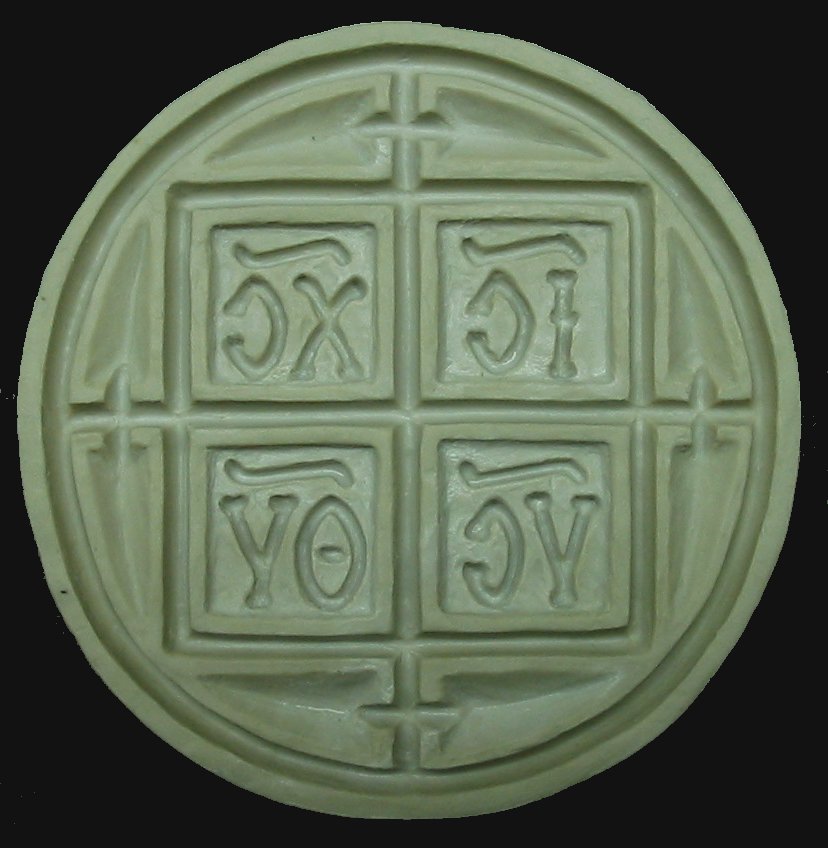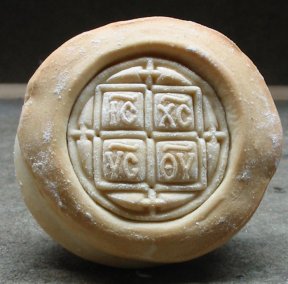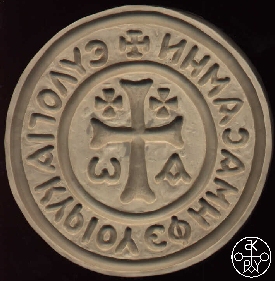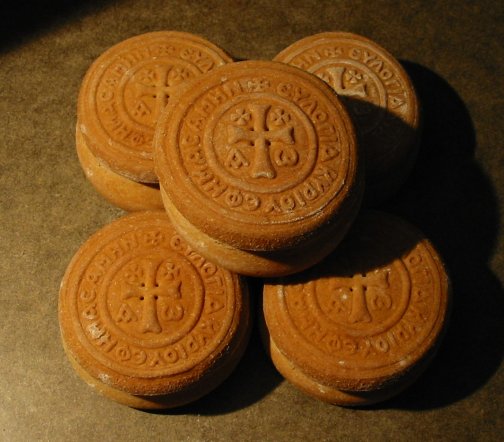
Chapter 6: Ancient Egypt and the Roman Empire
 |
Chapter 6: Ancient Egypt and the Roman Empire |
Material on the history of writing on food is thin and scattered. One can find a glimpse of that long tradition here and there and references to the practice, now and then, from pages in a book on some other subject. Nowhere is there to be found anything like a running history of the human practice of writing on food, until now. The history of escagraphs is certainly documentable in the first century AD and has roots that extend back to 3000 BC in Egypt.
There is some intriguing information that James Henry Breasted gives us in his Ancient Records of Egypt [1], expanded on by Darby, Ghaliougue and Grivetti in Food: the Gift of Osiris[2] that sheds some light on the origins of writing on bread. Breasted documents the placement of bread in tombs for the nourishment of the deceased during their long journey through the land of the dead. Were those loaves still there today they would be dust. The trio of authors of Food: the Gift of Osiris expand on Breasted's finding. They tell us that during the reign of Rameses III (New Kingdom - 1175-1144 BC), because grave robbers might enter a tomb, "...mortuary offerings were often replaced by clay or stone models of loaves or cakes, sometimes stamped with the name of the offerers. These could by prayer and magic effectively replace what they imitated..." If these authors have it right, then loaves made of stone, with the name of the giver inscribed on them, were placed in Egyptian tombs to assist the dead in their arduous journey through the land of the dead. Clearly, by resolving to place stone replicas of loaves of bread in tombs with their names on them, the mourners were soliciting the favor of the God who was to lead the recently deceased through the land of the dead just as he would soon enough be their guide. The expression "It couldn't hurt," comes to mind. And it was because of their decision to use stone loaves to thwart grave robbers that we have this evidence.
Even though the mortuary offerings were clay or stone models, having the name of the donor affixed to them, they are very suggestive that real loaves of bread could have been stamped with names even earlier than Ramses III. If the clay/stone loaves were attempts at simulation of the real thing, would the clay loaf have been stamped with a name unless the real loaf was? Galavaris[3] notes that the technology for impressing designs upon bread, by way of a stamp, is further documented in murals painted on Ramses III tomb walls. The painting shows a bakery with tools that appear to be stamps.
If we accept the mortuary loaves as evidence of writing on food, then the date for escagraph appearance is pushed back to about 1160 BC, at a conservative estimate. The writing on these loaves would have been in hieroglyphics.
By way of hieroglyphics, I believe that I can show that there was an Egyptian escagraph that predates even the mortuary loaf. It would be an escagraph of the Letterform category which were later used to celebrate moveable type. The Egyptians used a form of picture writing which Diringer[4] tells us, the Greeks called "...hieroglyphics grammata (from hieros, "holy," glyphein, "to carve," and gramma, "letter") because when it first came to their notice it was used and understood only by the priests..."
Hieroglyphics, Diringer continues, came into existence sometime in the early third millennium BC and began as pictures standing simply for what they were pictures of. That kind of writing was called pictographic writing. A picture of an owl, for example, stood for an owl. During its development, hieroglyphics took on a phonemic value, that is pictures began to stand for sounds as well as for what they were pictures of. For example, a picture of an object would stand for that thing of which it was a picture or for the first consonant sound of the object pictured (or for two or even three consonants in a cluster) so that, in time, hieroglyphics were pictures which stood for single or clustered consonants as well as things. Marks that stand for sounds are called phonograms. Pictures could even stand for ideas or concepts; for example, a picture of the sun might stand for the idea of "day." A picture which stood for an idea like "day" was called an ideograph.
At their height, hieroglyphic pictures could have as many as three or even four different designations. They could 1) be pictograms or 2) phonograms or 3) ideographs and some of the pictures were often used as 4) radicals, a mark indicating, for instance, femininity. This multiple usage caused interpreters of hieroglyphics no end of complication. In the spelling of Cleopatra's name, for example, the picture of a loaf of bread was not only a phonogram of the phoneme /t/ in her name but another bread loaf was there to indicate that the person mentioned was a woman (the radical).
The Egyptians wrote only with consonants, omitting the vowels. Eventually, they had a set of 24 consonants or consonant clusters, represented by pictures of things, which they used to represent the consonant sounds in their language, a basic consonant alphabet which remained unchanged for some thousands of years, Jensen[5] tells us. Of the 24 pictures, six were pictures of things which were ingestible: a vulture, a quail, a snake, an owl, water and bread. While I do not know about the dietary habits concerning all six of these, the last, bread, as we have already seen, was of special importance to the Egyptians not only in their diet but also in the structure of their culture.
They were the first people to practice the art of bread fermentation, letting their bread rise. The bread of Egypt was more than a foodstuff. For my argument, it is important to see just how important bread was to those people. The number of breads to which one had access was an economic measure, a sign of wealth. The ovens were mints. Wages were paid in breads, three breads and two jugs of beer were an average day's pay.
Egyptian bread was also shaped to please the eye. H.E. Jacob [6] points out that in the paintings of bakeries in tombs, there are round breads, cubical ones with domed tops, conical breads, braided breads and breads in the shapes of birds and fishes as well as breads in the shapes of pyramids. Of those breads, the first Jacob mentioned, the round loaf which was little more than a lump of dough left to rise so that it formed an hemisphere, was what the Egyptian scribes drew when they wanted to indicate either:
As they ate their bread, the priests and scribes who knew the 24 signs for consonants could hardly have missed noticing that the bread was the type for their many picture tokens for /t/. Can we conceivably imagine that they did not recognize an actual loaf of bread as a /t/? If you agree, then we have the oldest known Letterform escagraph established.
Just like the /a/ in alphabet pasta, that kind of escagraph is not writing on food but the machinery of writing that is food which was eaten every day in Egypt and held a major place in the administration, economy, and organization of that culture. It seems reasonable to recognize the hemispherical loaf of Egyptian bread as a Letter form escagraph.
Of the six pictures of ingestible things, which stood for consonants, water is also included. It was represented by a jagged line and stood for the nasal phoneme /n/ of their language. Six of the pictures the Egyptians chose to designate their 24 consonant alphabet were ingestible items, one quarter of their alphabet.
If we were to accept the Egyptian /t/ and /n/ as an earlier Letterform variety of the escagraph than the Informational Escagraph mortuary loaf and the Trademark Name escagraph loaf from Pompeii, then the origin of the escagraph could be safely pushed back to 2000 BC since that is a date for Egyptian hieroglyphic consonants to have become stable even though Egyptian hieroglyphic picture writing is dated in the third millennium BC. Whether or not Egyptians conversant with hieroglyphic phonograms made the escagraphic connection of /t/ and /n/ when they ate bread and drank water is not known; but, given the roles that those two commodities played in the Egyptian world - for was not bread the coin of the realm and the Nile the source of life? It is not farfetched to believe that some connection was understood to exist between those pieces of food and the sounds they stood for. Hindsight, and total familiarity with the use of an alphabet, makes the Egyptian loaf and water phonograms obvious to us as Letterform escagraphs. Alphabet scholars cavil at awarding the invention of the alphabet to the Egyptians because they wrote without vowels. Perhaps what we are looking at is a complete coincidence or perhaps it is the first traceable confluence of food and writing. Even if the Egyptians were unaware of the relationship of their food to their writing system, it is important for us to notice it.
Few examples of ancient escagraphs are extant for obvious reasons: Food is meant to be eaten and, if it isn't, it rots. By tragic natural accident, one ancient escagraph is extant in carbonized form[7]. Late in August, in 79 AD, Mount Vesuvius erupted and inundated the towns of Pompeii and Herculaneum on the bay of Naples. In Pompeii, a carbonized loaf of bread has been unearthed which carries the inscription "CELERIS GRANI VERI SER." English translation, thanks to the help of Anne Dicks[8], Head of Classics at Malvern St. James is: "Of Celer, slave of Q. Granius Verus." Here is her reasoning: Celer is a Roman name; when you want to say ‘of Celer' or ‘Celer's', it becomes Celeris. Servus means slave. In this phrase it would agree with the name ‘Celer' and would also need to be the equivalent of "of the slave'" or "the slave's". SER is here short for servi. The bakery where the bread was made must have been run by Celer and his master would want all the customers to remember where they had the bread from, since it would not have had a printed wrapping. Because Celer is Quintus Granus Verus's slave, all the words of his name also need to have the Latin equivalent of the apostrophe ‘s'. In full, the name of the bakery owner in the possessor mode (or genitive case) would be Quinti Grani Veri. If written in full, the inscription would read, "CELERIS QUINTI GRANI VERI SERVI".
The inscription, then, tells us who made the bread and at which bakery. It has about it the characteristics of other Roman trademarks of that period which have been found upon many everyday items like pottery and eye salve. Dates, maker's name, place of manufacture, and occasionally, the name of the Emperor and/or other public officials, were placed on many manufactured goods in the Roman world. The Pompeii inscription was pressed into the dough before baking and is a very clear and well executed set of words. That loaf of bread was not the only such loaf found during the excavation of Pompeii. Pierre Gusman[7] tells us "In the ovens of the bake house whole loaves were found carbonized. Several of them have the name of the baker marked on them and are made of finer dough than the rest." In the Michigan Law Review, Edward S. Rogers[9] makes a point of the Roman practice of inscribing sundry objects with trademarks and concludes: "It is hardly too much to say that trademarks played almost the same part in Ancient Roman commercial life as they do today." Roman oculists stamped their name into the cakes of their eye salve along with the formula of the substance and the directions for its use says Paster in Trademarks - Their Early History [10]. But the use of a trademark stamped upon goods was not a Roman invention. The Chinese marked pottery with the name of the period's Emperor and/or the name of the maker as early as 2700 BC and every brick that was used to make the palace of Nebuchadnezzar was marked with his name.
The loaf of bread from Pompeii has a trademark on it and is similar to many escagraphs today. The writing on the loaf from Pompeii is well executed which leads to the conclusion that, on that tragic day in 79 AD was not the first on which a loaf of bread carried some inscription. The practice of shaping, stamping, molding and inscribing bread, along with the technology for doing so were all well in use before that day.
Much of what we know about the habit of writing on bread has to do with the
technology for doing so and not the actual piece of food. The technology has
survived, the food has not. In his book, Bread and the Liturgy, George
Galavaris[3]
mentions a date, nearly two centuries older than the loaf from Pompeii, when
bread may have been inscribed with a name. He also mentions how that inscribing
was done.
Bernice, daughter of
King Ptolemy III of Hellenistic Egypt (247-221 BC) was proclaimed a goddess
by decree after her death. A section of the decree contains instructions for the
bread which was to be given to the wives of the Priests who served the new
goddess. It was to be marked and called the bread of Bernice, and possibly
carried her likeness (as on a coin) and her name applied with a stamp.


Stamps and stamped bread with replicas of these historical images are still
evident today, produced by
Fr. George Aquaro for liturgical purposes.


The bread of Bernice, while it may have had a name on it and so would look like a trademark, was marked for other reasons than a trademark designation. Her name on the bread would set it aside especially and solely for the worshipers of Bernice. The Eastern Church today still uses leavened bread for the Eucharist and it is marked to designate that it is not to be used for any other purpose. H.E. Jacob sums up bread's influence in the ancient world in his Six Thousand Years of Bread[6]:
Bread reigned over the ancient world; no food before or after exerted such mastery over men. The Egyptians, who invented it, based their entire administrative system upon it, the Jews made bread the starting point of their religious and social laws. The Greeks created profound and solemn legends for their Bread Church of Eleusis. And the Romans converted bread into a political factor. They ruled by it, conquered the entire world by it, and lost the world again through it.
home - links - table of contents - copyright - contact us - author
Copyright (c) 2007 - 2021 North6 Ltd.